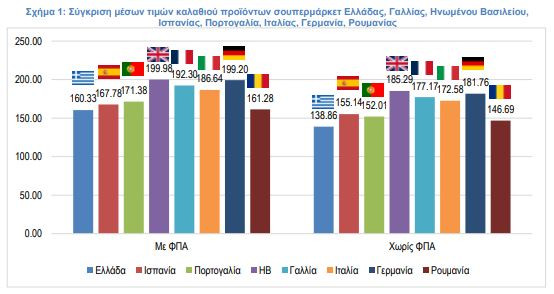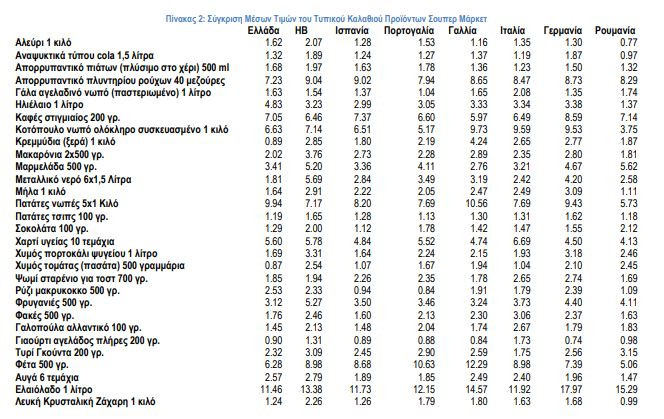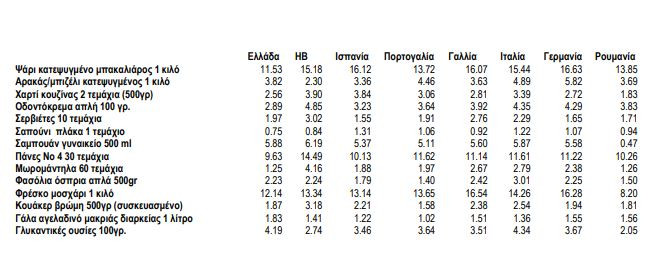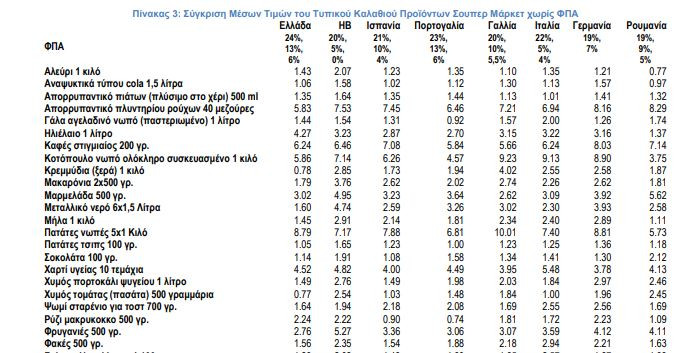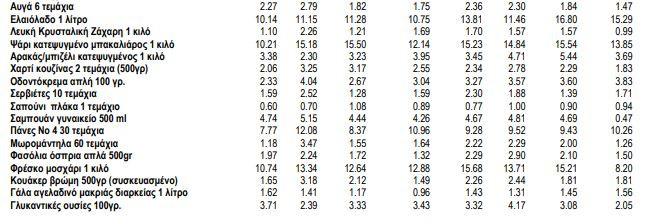The IELKA survey compares the prices of basic products in Greece with other countries
The prices of the typical household basket remain lower in Greek supermarkets compared to the corresponding stores in France, England, Italy, Spain, Portugal, Germany and Romania according to research by the Research Institute of Consumer Goods Retail (IELKA).
In particular, the report of the Consumer Goods Retail Research Institute (IELKA) presents the results of an organized price comparison survey (based on data from price comparison platforms in each country, but also on price quotes from supermarket chains) on a typical household product basket of organized retail food (supermarket) in Greece in March 2024 and respectively in France, the United Kingdom, Spain, Italy, Portugal, Germany and Romania. The price comparison is made with and without the value of VAT, which differs in each country.
For this analysis, prices were compared in a total of 43 product categories:
- 20 product sub-categories that make up a typical shopping basket, as it has been shaped in this repeat survey from 2012 to the present.
- 18 product subcategories included in the household basket from 11/2022
- 5 subcategories of products included in the household basket from 3/2023
These product sub-categories are examined from a significant sample of over 6,000 product prices and 40 different supermarket chains in the eight countries in total to calculate the average prices, with sampling from valid price comparison sites in Greece and abroad, but also from supermarket chains. The figures include both prices of products on sale and private label products in each country. It is clarified that the prices refer only to supermarket chains and not to other points of sale.
The comparison of average basket prices (table 1) shows that all five countries have a significantly more expensive average basket than Greece, 24% Germany, 20% France, 25% United Kingdom, 16% Italy, 7% the Portugal, while Spain and Romania are quite close to Greece but more expensive by 5% and 1% respectively.
The picture of the results changes significantly when we remove the relevant VAT per country to understand the real prices of supermarket products. Comparing the baskets in this case (figure 1 and table 1) shows that all six countries have a more expensive average basket than Greece, Germany by 31%, France by 28%, the United Kingdom by 33%, Italy by 24%, Spain by 12%, Portugal by 10% and Romania by 6%. This is a result of the difference in the low VAT per country (this is the VAT referred to food and drinks). In Greece this VAT is 13%. VAT is significantly higher than the UK (0% or 5%) and France (10% and 5.5%), Spain (10% and 4%), Portugal (13% and 6%), Italy (5% and 4%), Germany (7%) and Romania (9%), but also most EU countries. The main difference is that food in Greece is subject to the high VAT rate with 24% in the rest countries are subject to the low VAT rate, which is even lower than the Greek rate of 6%, 5.5%, 4% or even 0%. It is noted that the effect of special consumption taxes (e.g. coffee) cannot be included in the above figures.
The general conclusion that emerges from the above analysis is that the organized Greek food retail trade (supermarket) provides Greek consumers with access to products for their typical basket at lower prices on average which is the result of the organized effort of suppliers and retailers to price restraint in recent years. This trend, with minor fluctuations, has been consistent over the last 12 years that this research has been carried out by IELKA. The long-term price comparison with abroad shows that in recent years Greece has consistently had a cheaper basket than the compared countries with fluctuations that do not change the general conclusion of the analysis.
It is noted that in addition to VAT, factors that should be taken into account when comparing prices between different countries are:
- The amount of taxation in each country
- The consumption habits in each country (e.g. the trend for packaged or non-packaged products, private label products, etc.)
- Natural disasters due to climate change
- The distance of the country from the production centers of central Europe and the corresponding costs
- The cost of energy
- The cost of fuel and general transport
- The complexity of the geography of each country (e.g. road network, islands etc.)
- Market size, purchasing power and corresponding economies of scale in product procurement
- The export-import balance in relation to food and raw materials for its manufacture
- The various production costs (energy, raw materials, wage costs, financial costs, bureaucracy)
- The productivity of industry and retail trade in each country
- The seasonality of demand and supply (e.g. due to tourism or weather conditions)
- The salary-labor cost
The price data are calculated from well-known price observatories of the countries examined and for Greece in the primary data from price collections in large supermarket chains. The selection criteria of the products in the basket were a combination of corresponding used baskets for evaluation abroad, as well as common availability of price data in the countries examined. In each new measurement, the sample of the codes being measured is updated and depending on the availability, different quantities of products are selected.
The data comes from the following supermarket chains, while the average prices per subcategory and per country are presented in tables 2 and 3:
− Greece: Sklavenitis, AB, My Market, Masoutis, Market In
− United Kingdom: Morrisons, ASDA, Sainsbury’s, Coop, Ocado, TESCO
− Spain: Carrefour, Marcadona, Caprabo, Condis, Dia, Eroski, SoySuper. Alcampo
− Italy: CosiComodo, emiDrive, Pim Spesa, Agora, Everli, HeyConad, easyCoop
− Portugal: Continente, Minipreco, Auchan, Spar
– France: Monoprix Plus, Carrefour, Super U, Auchan, Aldi
− Germany: Rewe, Kaufland, Netto, Tukwila
– Romania: Kaufland, Tommy, Spar, Konzum
Below is table 3 with the data per product with VAT and table 4 without VAT
Source: Skai
I am Janice Wiggins, and I am an author at News Bulletin 247, and I mostly cover economy news. I have a lot of experience in this field, and I know how to get the information that people need. I am a very reliable source, and I always make sure that my readers can trust me.


